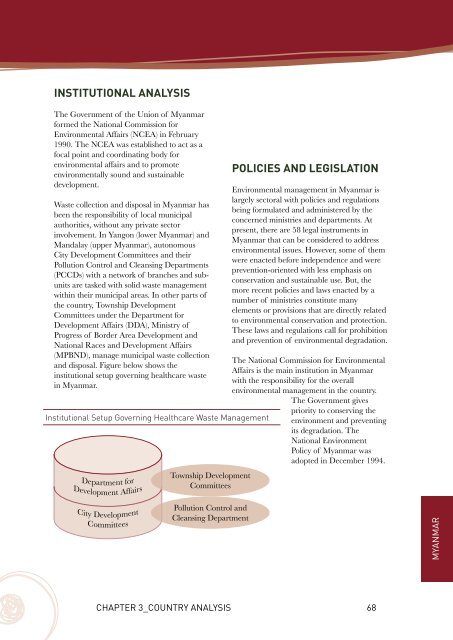Healthcare Waste Report - Environment Health
Healthcare Waste Report - Environment Health
Healthcare Waste Report - Environment Health
You also want an ePaper? Increase the reach of your titles
YUMPU automatically turns print PDFs into web optimized ePapers that Google loves.
INSTITUTIONAL ANALYSIS<br />
The Government of the Union of Myanmar<br />
formed the National Commission for<br />
<strong>Environment</strong>al Affairs (NCEA) in February<br />
1990. The NCEA was established to act as a<br />
focal point and coordinating body for<br />
environmental affairs and to promote<br />
environmentally sound and sustainable<br />
development.<br />
<strong>Waste</strong> collection and disposal in Myanmar has<br />
been the responsibility of local municipal<br />
authorities, without any private sector<br />
involvement. In Yangon (lower Myanmar) and<br />
Mandalay (upper Myanmar), autonomous<br />
City Development Committees and their<br />
Pollution Control and Cleansing Departments<br />
(PCCDs) with a network of branches and subunits<br />
are tasked with solid waste management<br />
within their municipal areas. In other parts of<br />
the country, Township Development<br />
Committees under the Department for<br />
Development Affairs (DDA), Ministry of<br />
Progress of Border Area Development and<br />
National Races and Development Affairs<br />
(MPBND), manage municipal waste collection<br />
and disposal. Figure below shows the<br />
institutional setup governing healthcare waste<br />
in Myanmar.<br />
Institutional Setup Governing <strong><strong>Health</strong>care</strong> <strong>Waste</strong> Management<br />
Department for<br />
Development Affairs<br />
City Development<br />
Committees<br />
Township Development<br />
Committees<br />
Pollution Control and<br />
Cleansing Department<br />
CHAPTER 3_COUNTRY ANALYSIS<br />
POLICIES AND LEGISLATION<br />
<strong>Environment</strong>al management in Myanmar is<br />
largely sectoral with policies and regulations<br />
being formulated and administered by the<br />
concerned ministries and departments. At<br />
present, there are 58 legal instruments in<br />
Myanmar that can be considered to address<br />
environmental issues. However, some of them<br />
were enacted before independence and were<br />
prevention-oriented with less emphasis on<br />
conservation and sustainable use. But, the<br />
more recent policies and laws enacted by a<br />
number of ministries constitute many<br />
elements or provisions that are directly related<br />
to environmental conservation and protection.<br />
These laws and regulations call for prohibition<br />
and prevention of environmental degradation.<br />
The National Commission for <strong>Environment</strong>al<br />
Affairs is the main institution in Myanmar<br />
with the responsibility for the overall<br />
environmental management in the country.<br />
The Government gives<br />
priority to conserving the<br />
environment and preventing<br />
its degradation. The<br />
National <strong>Environment</strong><br />
Policy of Myanmar was<br />
adopted in December 1994.<br />
68<br />
MYANMAR

















